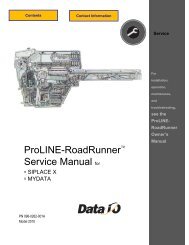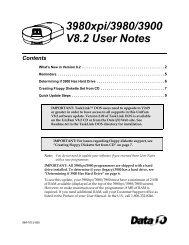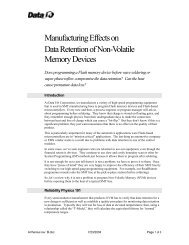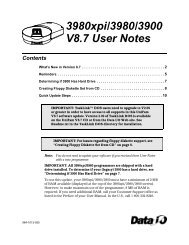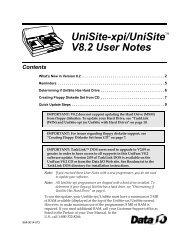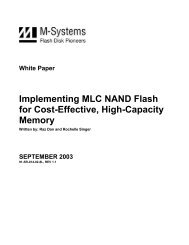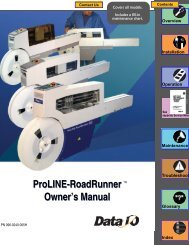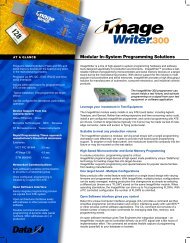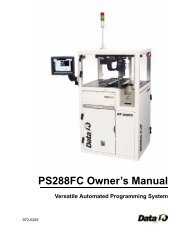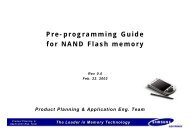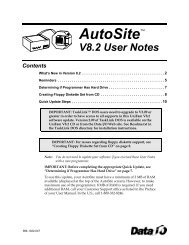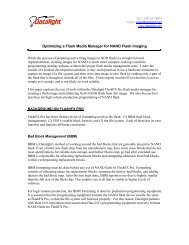3980xpi Users Manual - Data I/O Corporation
3980xpi Users Manual - Data I/O Corporation
3980xpi Users Manual - Data I/O Corporation
You also want an ePaper? Increase the reach of your titles
YUMPU automatically turns print PDFs into web optimized ePapers that Google loves.
Format Select<br />
Input From Disk<br />
Commands<br />
� I/O Addr Offset<br />
Specifies the beginning address of the downloaded data file to be<br />
compared. This field appears only when a non-JEDEC format has been<br />
selected. Entering FFFFFFFF causes the programmer to default to the first<br />
incoming address as the lowest address to be compared.<br />
� Memory Begin Address<br />
Specifies the first hexadecimal address of data to compare with data from<br />
the Source port. If the data location is RAM, it is a beginning RAM address.<br />
If the data location is Disk, it is a beginning disk file address. This field<br />
appears only when a non-JEDEC format has been selected. The default<br />
address is 0.<br />
� User <strong>Data</strong> Size<br />
Specifies the hexadecimal size, in bytes, of the data block to be<br />
downloaded and compared from the Source to the data location. This field<br />
appears only when a non-JEDEC format has been selected. Normally, you<br />
should enter a zero here so all the data is compared. After the compare<br />
operation is complete, a value equal to the number of bytes compared is<br />
set here. If a value less than the size of the data received is entered, only<br />
the number of bytes equal to that value are actually compared.<br />
� Download Host Command<br />
Enter the appropriate host command line here to download the data. This<br />
line may be up to 58 characters long. The programmer generates a return<br />
character to terminate the line when transmitted to the host. To clear a<br />
previously entered command, press SPACE then ENTER.<br />
More Commands / Transfer <strong>Data</strong> / Format Select<br />
The Format Select command selects the translation format to use. Translation<br />
formats (a form of transmission protocol) are used when data is uploaded or<br />
downloaded between the programmer and a host computer. Chapter 5 lists<br />
and describes the formats supported by the programmer. If your host<br />
computer does not generate code into one of the listed formats, edit it to<br />
match one of the supported formats.<br />
The Format Select screen lists the programmer supported formats to choose<br />
from. Enter the number of the format that you want to use in the format entry<br />
field at the bottom of the screen, then press ENTER. When you select a<br />
translation format from this screen, the same format is entered in all the other<br />
Transfer <strong>Data</strong> screens (such as, Download <strong>Data</strong> and Compare <strong>Data</strong>).<br />
More Commands / Transfer <strong>Data</strong> / Input From Disk<br />
Use this command to load a data file from disk if the data is stored in a<br />
translation format. Depending on the settings of the Destination parameter,<br />
the data in the disk file is loaded into either RAM or another disk file.<br />
To input a data file from disk, follow these steps:<br />
1. Insert the disk containing the file to input into the drive.<br />
2. Specify the settings for the parameters listed below.<br />
3. Press ENTER to start this command. The programmer displays <strong>Data</strong><br />
transfer complete when the file has been loaded.<br />
<strong>3980xpi</strong>/3980/3900/2900 User <strong>Manual</strong> 4-65




